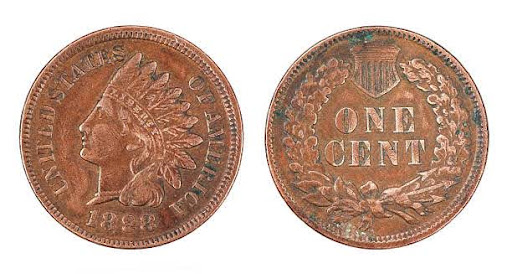The Indian Head Penny: A Unique and Captivating History
The Indian Head penny minted from 1859 to 1909 when it was replaced with the Lincoln cent. These coins stand out as some of the most fascinating coins in U.S. history. Designed by James B. Longacre, the Indian Head penny design portrays Liberty wearing a Native American headdress. This artistic choice reflected the growing spirit of American identity during the 19th century.
While the image on the coin is not an actual Native American, the symbolic headdress has come to represent the ideals of liberty, growth, and independence. Thus, making the Indian Head cent a beloved coin among collectors and history enthusiasts alike.
The Origins of the Indian Head Penny
Before the Indian Head penny, the U.S. Mint produced the Flying Eagle cent, a short-lived coin because of production difficulties. The Indian Head penny replaced it in 1859, and the new design was intended to symbolize a strong and independent America. The obverse design on the back of the penny originally featured a simple wreath of laurel leaves. This was later replaced in 1860 with a shield and oak wreath design to represent strength and unity.
The Indian Head coins became a symbol of the nation’s expansion and industrial growth, produced as the country moved westward and developed into a global power. This coin was widely circulated, reflecting the everyday life of Americans during a critical period of the nation’s development. It holds a special place in American history, as it was in circulation during major events like the Civil War, the Reconstruction era, and the turn of the 20th century.
Noteworthy Dates and Variations
Most Indian Head pennies are appreciated for their historical significance rather than their rarity. Nevertheless, some dates and mint marks stand out to collectors. For example, the 1877 Indian Head penny is particularly sought after. This is because of its low mintage that year, making it one of the most desirable for numismatists.
Similarly, the 1908-S and 1909-S Indian Head pennies, produced at the San Francisco Mint, are significant because they were part of the final years of the coin’s production and had relatively low mint numbers.
One interesting variation includes the “overdate” coins, such as the 1869/69 variety. This coin shows a visible overstrike where the date was restamped, adding a layer of complexity and intrigue for collectors. Other notable examples include the 1873 “Closed 3” and “Open 3” variations, in which slight differences in the typography of the number ‘3’ create different subtypes for that year.
While rarities like these can sometimes fetch high prices, many collectors are drawn to Indian Head pennies regardless of their scarcity because of their distinctive design and historical importance. Even well-worn coins from common years can be a source of pride for collectors who appreciate the aesthetic and narrative of these coins.
The Role of Condition in Valuation
When assessing the value of an Indian Head penny, condition plays an essential role. Coins are typically graded on a scale from Poor (P-1) to Mint State (MS-70), with the higher grades reserved for coins that have been carefully preserved and show little to no wear.
Uncirculated Indian Head pennies in mint condition can sometimes achieve significant prices. This is especially true when paired with key dates or rare variations. However, many collectors are just as enthusiastic about acquiring coins in “good” or “very good” condition, appreciating the history and journey these coins have endured through time.
The grading process is often handled by professional numismatic grading services, such as PCGS (Professional Coin Grading Service) or NGC (Numismatic Guaranty Corporation).
These services can authenticate and grade coins, providing collectors with peace of mind about their coin’s quality and legitimacy. Many collectors prefer to have their more valuable coins certified by such services. Additionally, grading can increase both the value and ease of sale.
Why Collect the Indian Head Penny?
For many coin collectors, Indian Head pennies offer a tangible connection to America’s past. These coins circulated during pivotal moments in U.S. history. They were found in American pockets from the Civil War to the dawn of the automobile age. Collectors often feel a sense of nostalgia and national pride when holding an Indian Head penny, imagining the many hands it may have passed through over the last century.
Additionally, the artistry and craftsmanship behind the design make Indian Head pennies more than just historical artifacts—they’re miniature works of art. Longacre’s depiction of Liberty with a Native American headdress is a unique blend of American iconography. Moreover, the intricate detailing on both the obverse and reverse sides of the coin has held the fascination of collectors for generations.
Selling Your Indian Head Pennies
If you have Indian Head pennies in your possession, selling them can be a rewarding experience. At Chicago Gold Gallery, we’re always looking to buy Indian Head pennies, as well as other historical or rare coins. Whether you have a single coin or an entire coin collection, we provide fair and competitive offers based on the current market value and condition of your coins.
Our experienced team is here to guide you through the appraisal process, ensuring transparency and honesty in every transaction. We pride ourselves on offering fair prices, making it easy for you to sell your Indian Head pennies with confidence. Don’t let these fascinating pieces of history gather dust—bring them to Chicago Gold Gallery, and we’ll help you unlock their full potential.
Visit us today for a free appraisal and discover what your Indian Head pennies are truly worth.
